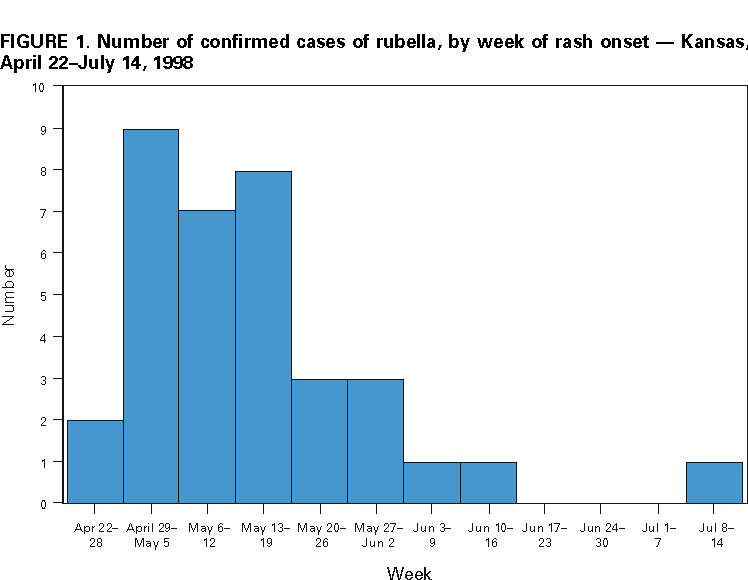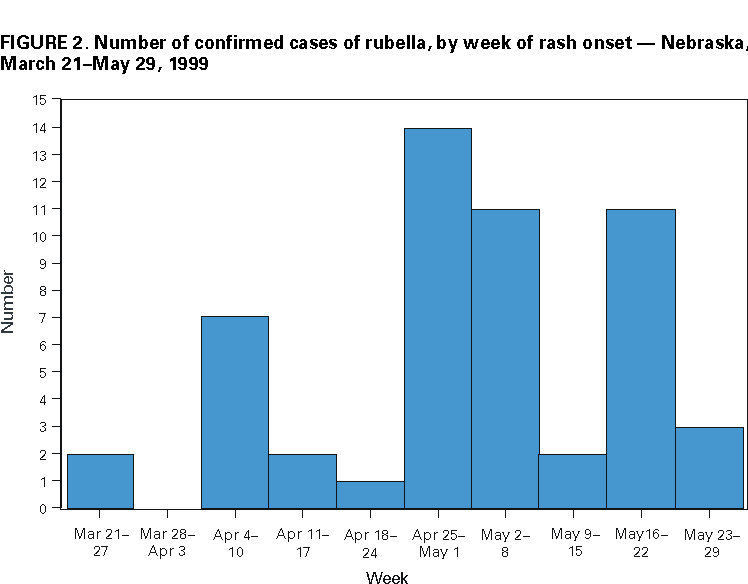 |
|
|
|
|
|
|
| ||||||||||
|
|
|
|
|
|
|
||||
| ||||||||||
|
|
|
|
|
Persons using assistive technology might not be able to fully access information in this file. For assistance, please send e-mail to: mmwrq@cdc.gov. Type 508 Accommodation and the title of the report in the subject line of e-mail. Rubella Among Hispanic Adults --- Kansas, 1998, and Nebraska, 1999Since 1994, the incidence of rubella has been low; most reported rubella cases have been associated with outbreaks (1,2). Recent outbreaks have occurred primarily among adult Hispanics, many of whom are natives of countries where rubella vaccination is not routine or has been implemented recently (1). This report describes two workplace-associated outbreaks of rubella and summarizes the characteristics of the recent outbreaks in the United States. KansasDuring April 22--July 14, 1998, 35 confirmed cases of rubella were reported to the Kansas Department of Health and Environment (Figure 1), compared with one case in 1997 and no cases during January--April 1998. The first case was identified in a 45-year-old Hispanic female employee of a meat-packing plant who developed the characteristic rubella rash on April 22. Of the 35 confirmed cases, 28 (80%) occurred in employees in meat-packing plants in the same region. The median age was 29 years (range: 3 months--47 years); 27 (77%) were men. Of the eight cases among females, four occurred among women of childbearing age; two were infected during pregnancy (one in the second and one in the third trimester). Both women delivered full-term, healthy infants who had no clinical findings suggestive of rubella and had negative rubella IgM antibodies. Of the 35 confirmed cases, 28 (80%) occurred among Hispanics. Of the 32 case-patients with known place of birth, 20 (63%) were born outside the United States in Latin American countries (15 in Mexico, four in El Salvador, and one in Guatemala). Of these, the median length of residence in the United States was 9.5 years. The median age of U.S.-born case-patients during the Kansas outbreak was 34.5 years, compared with 26.5 years in foreign-born case-patients. Active surveillance for rubella was established in counties where cases had been reported and in adjacent counties. From May 8 to June 19, 1998, worksite vaccination clinics were established in six Kansas meat-packing plants. Clinic activities included 1) screening for persons who presented with rash or who had a history of rash illness during the previous 2 months; 2) vaccination with measles, mumps, and rubella vaccine (MMR) for every consenting employee without contraindications and without proof of rubella immunity; and 3) serologic testing of pregnant women. At these clinics, 7334 doses of vaccine were administered, and 64% of plant employees were vaccinated. An additional 1210 doses of MMR were administered in clinics established in county health departments, associated workplaces (e.g., cattle-feeding farms), and Spanish- language churches. The last confirmed case of rubella associated with this outbreak was reported in Kansas on July 11, 1998. NebraskaOn April 1, 1999, a 29-year-old Hispanic man residing in Omaha sought treatment at a local sexually transmitted diseases clinic. He had a rash, low grade fever, and lymphadenopathy and tested positive for rubella-specific IgM. He worked in a meat-packing plant. Seven additional cases subsequently were detected in the same plant. Rubella surveillance was enhanced and, during March 21--May 29, the Douglas County Health Department identified 53 confirmed cases of rubella (Figure 2), compared with none for the previous 8 years. Of these, 44 (83%) occurred among Hispanics born outside the United States, and 45 (85%) occurred either among workers in a meat-packing plant or who resided in the same household with a meat-packing--plant worker. Four cases occurred among pregnant women; two were in the first trimester. Outbreak control measures included mass vaccination campaigns in the community, encouragement by health-care providers to receive vaccination (e.g., assuring that missed opportunities were minimized and vaccinating all family members with no contraindications at the health-care visit), collaboration with the Special Supplemental Food Program for Women, Infants and Children (WIC) to reach potentially under-vaccinated populations, and efforts to increase community awareness. Rash onset for the last reported case-patient was July 27, 1999. A total of 95 cases of rubella associated with this outbreak have been reported to the Nebraska Health and Human Services System. Reported by: D Langvardt, G Pezzino, M Mayer, C Miller, Kansas Dept of Health and Environment. J Weston, C Allensworth, Douglas County Health Dept, Omaha; R Raymond, Nebraska Health and Human Svcs System. RC Jones, Rollins School of Public Health, Emory Univ, Atlanta, Georgia. Child Vaccine Preventable Diseases Br, Vaccine Safety and Development Br, Epidemiology and Surveillance Div, National Immunization Program; Measles Virus Section, Respiratory and Enteric Viruses Br, Div of Viral and Rickettsial Diseases, National Center for Infectious Diseases; and an EIS Officer, CDC. Editorial Note:During 1969--1989, the annual number of reported cases of rubella in the United States decreased 99.6% as a result of a successful childhood vaccination program (1). Indigenous rubella is targeted for elimination in the United States by the end of 2000 (3). However, approximately two thirds of other countries did not routinely vaccinate against rubella before 1997 (2). Rubella remains endemic in many Latin American countries, and large epidemics of rubella occur periodically. For example, during January--June 1998, approximately 25,000 cases of rubella were reported to the Ministry of Health in Mexico. During 1996--1998, 14 rubella outbreaks were reported in the United States (median number of reported cases: 21; range: eight--95). Seven outbreaks were workplace associated and most occurred among workers at food-processing plants or other industries employing predominantly foreign-born workers. Most cases reported in these outbreaks occurred among persons of Hispanic origin (median: 92.5%; range: 32%--100%). No case-patients in the Kansas or Nebraska outbreaks reported having received rubella vaccination. Although rubella is near record low levels in the United States, epidemics continue to occur among susceptible foreign-born adults. Workers born outside the United States are a potentially susceptible population in which outbreaks may occur after importation of the virus from areas outside the United States where rubella is endemic. Vaccinating against rubella in workplaces is a strategy to reach this susceptible population and can be a critical step in eliminating indigenous rubella. Public health professionals, other health-care professionals, and industrial health-care services should design appropriate programs to assure high coverage of foreign-born employees with rubella vaccine. References
Figure 1  Return to top. Figure 2  Return to top. Disclaimer All MMWR HTML versions of articles are electronic conversions from ASCII text into HTML. This conversion may have resulted in character translation or format errors in the HTML version. Users should not rely on this HTML document, but are referred to the electronic PDF version and/or the original MMWR paper copy for the official text, figures, and tables. An original paper copy of this issue can be obtained from the Superintendent of Documents, U.S. Government Printing Office (GPO), Washington, DC 20402-9371; telephone: (202) 512-1800. Contact GPO for current prices. **Questions or messages regarding errors in formatting should be addressed to mmwrq@cdc.gov.Page converted: 3/23/2000 |
|||||||||
This page last reviewed 5/2/01
|